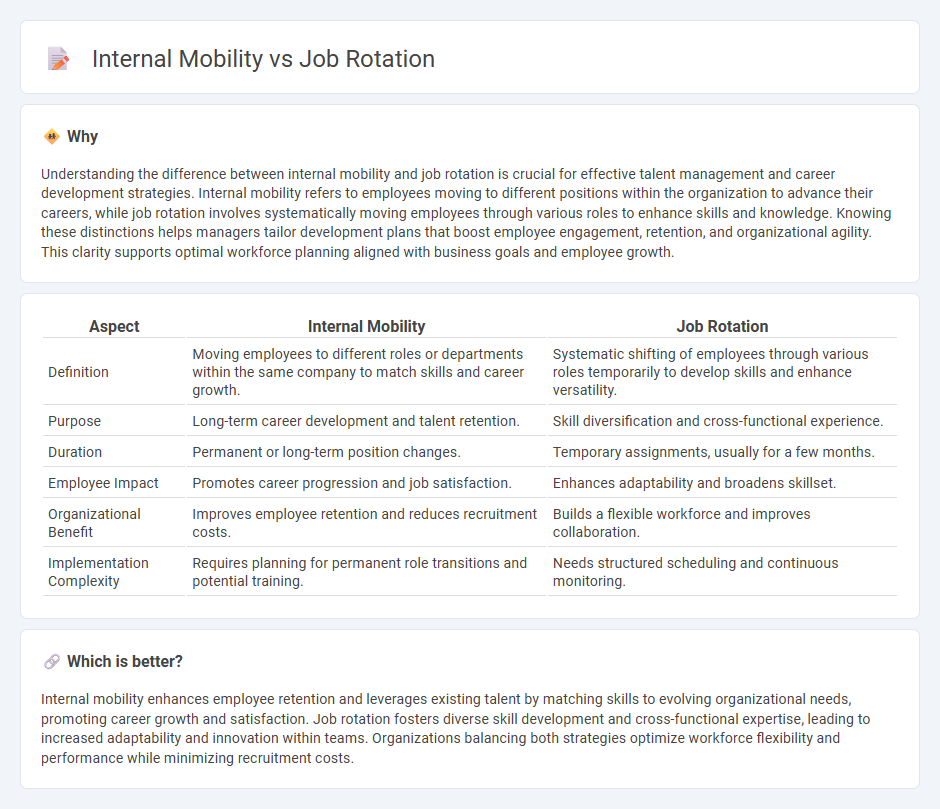
Internal mobility enhances employee retention by enabling career growth within the organization, while job rotation broadens skills through systematic exposure to varied roles. Both strategies improve workforce flexibility and organizational agility by matching talent with evolving business needs. Discover how leveraging these approaches can optimize talent management and drive long-term success.
Why it is important
Understanding the difference between internal mobility and job rotation is crucial for effective talent management and career development strategies. Internal mobility refers to employees moving to different positions within the organization to advance their careers, while job rotation involves systematically moving employees through various roles to enhance skills and knowledge. Knowing these distinctions helps managers tailor development plans that boost employee engagement, retention, and organizational agility. This clarity supports optimal workforce planning aligned with business goals and employee growth.
Comparison Table
| Aspect | Internal Mobility | Job Rotation |
|---|---|---|
| Definition | Moving employees to different roles or departments within the same company to match skills and career growth. | Systematic shifting of employees through various roles temporarily to develop skills and enhance versatility. |
| Purpose | Long-term career development and talent retention. | Skill diversification and cross-functional experience. |
| Duration | Permanent or long-term position changes. | Temporary assignments, usually for a few months. |
| Employee Impact | Promotes career progression and job satisfaction. | Enhances adaptability and broadens skillset. |
| Organizational Benefit | Improves employee retention and reduces recruitment costs. | Builds a flexible workforce and improves collaboration. |
| Implementation Complexity | Requires planning for permanent role transitions and potential training. | Needs structured scheduling and continuous monitoring. |
Which is better?
Internal mobility enhances employee retention and leverages existing talent by matching skills to evolving organizational needs, promoting career growth and satisfaction. Job rotation fosters diverse skill development and cross-functional expertise, leading to increased adaptability and innovation within teams. Organizations balancing both strategies optimize workforce flexibility and performance while minimizing recruitment costs.
Connection
Internal mobility enhances employee development by facilitating job rotation, which exposes staff to diverse roles and skills within the organization. Job rotation supports talent retention and knowledge transfer by preventing stagnation and fostering adaptability in management. Together, these strategies optimize workforce agility and align employee growth with organizational goals.
Key Terms
Skill Development
Job rotation enhances skill development by exposing employees to diverse roles and tasks, fostering adaptability and broadening their expertise across multiple functions. Internal mobility supports skill growth through targeted career progression within the organization, allowing employees to deepen specialization and leverage accumulated knowledge in new positions. Explore how strategic implementation of job rotation and internal mobility can accelerate comprehensive skill development tailored to organizational goals.
Talent Retention
Job rotation enhances employee skills by exposing them to various roles within the organization, which fosters engagement and reduces turnover. Internal mobility facilitates career advancement by enabling employees to move laterally or vertically, promoting long-term retention and organizational loyalty. Discover how integrating both strategies can optimize your talent retention efforts.
Career Progression
Job rotation offers employees diverse experiences by moving them across different roles, enhancing skill sets and adaptability within the organization. Internal mobility emphasizes career progression through lateral moves or promotions, fostering long-term growth and retention. Explore how leveraging job rotation and internal mobility strategically can accelerate your career development.
Source and External Links
Job Rotation - Job rotation involves moving employees between jobs without changing their rank or salary, enhancing skills and reducing monotony.
Job Rotation | EBSCO - Job rotation is a strategy to develop a broad range of skills by moving employees across different roles within an organization.
Job Rotation: Types, Training Methods, Benefits - Job rotation involves moving employees to different positions or departments to broaden their skills and understanding of the organization.
 dowidth.com
dowidth.com